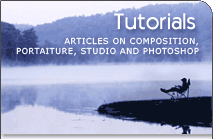Lens Choice
In this article I would like to share my knowledge and thoughts about lens in consideration of focal length and how it affects the photographs. Here you will get an idea how to improve your photograph by using different focal length.
Focal Length & Angle
These two terms: Focal Length and Angle of view are very tightly related, and even you probably very well aware about a focal length that is used to mark the lens, i.e. something like 28-105mm f3.5-5.6 for zoom and 50mm f1.4 for lens with fixed focal length. But if you look for specification of the lens you have, among the parameters you will see the degree of the angle.
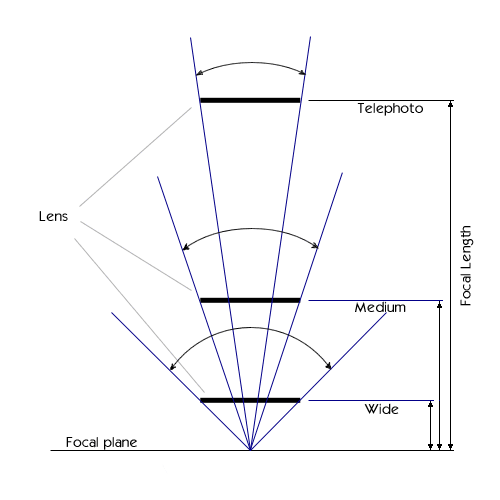
On the diagram above you may see the correlation between the focal length (the distance from the focal plane/point of focus to the lens) and the angle of view. Usually there are more than one piece of glass in the lens, but there is one plane that is considered to be the lens plane. So the angle is wider when the lens is closer to the focal plane (remember the name "wide-angle lens"?) and the angle is small when the lens are farther away.
There is another element, which affects the angle - the format of the camera. You probably know three basic types of camera formats: 35mm, Medium Format and View camera. Each lens designed in such a way that they direct the light to a certain spot on the focal plane. This spot has a form of a circle, but the frame of the film or digital chip has a shape of a square or a rectangle. So the frame is placed inside the circle, and it doesn't always fit tightly. Take for example digital SLR cameras with a smaller chip than 35mm frame - their chip smaller than the 35mm frame, but the lens used the same, and the light spot on the focal plane still has the same size. Well, I hope after my short explanation your understand the idea of the focal length and its correlation to the angle of view slightly better. Now, lets return to the photography and what the focal length and view angle mean to photographers.
~ Top ~Perspective
Further in the article I will often use the term "perspective", so I'd better explain its meaning. The definition of the perspective sounds like that: "The technique of representing a three-dimensional world (what we see) on a two-dimensional surface (a piece of paper or canvas)." And the choice of lens, or better said "the choice of the focal length", can dramatically increase this feeling of perspective or otherwise make the image flat. And the latter is not always bad, sometimes you want this particular effect, but read on.
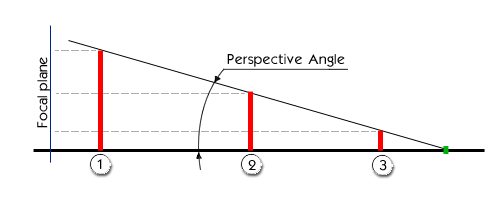
When we see objects with our own eyes, the perspective could be represented by the relative size of those objects, especially when two or more objects of the similar size (as we know them - not see), but on various distance from us, look differently - objects closer to us seem to be bigger, while farthest objects are very small and sometimes vanish in a dot. This concept I tried to express on the diagram above. I am not sure that there is such a term as "perspective angle" (I am not that technical), but it could help me in explaining the relation between perspective and angle of view. So, if we consider that the objects 1, 2 and 3 on the diagram have a similar height and the small green dot to be the point where all objects are seen as a dot, then there is a definite line along which the object change their sizes. And the line creates an angle with the ground (flat surface the objects reside upon), which I will call the perspective angle.
This perspective angle has a similar value/degree for all human beings because of the physics of our eyes (we have our own focal length in the eye). But the perspective angle could be represented differently on a photograph, and this difference is directly related to the lens' angle of view.
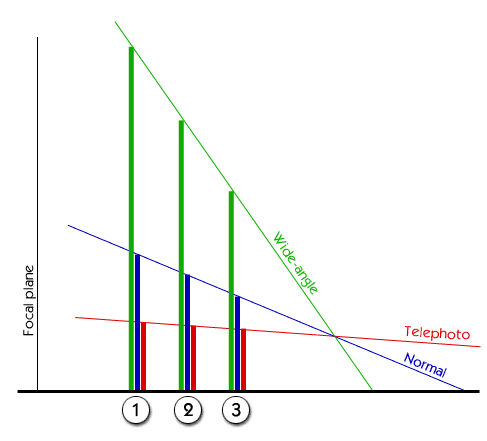
On the diagram I've depicted the perspective angle of our eye as normal (which is somewhere in the medium range of lens) and the other two lines represent wide-angle lens range and telephoto range. And again the three objects (vertical bars named as 1, 2 and 3) have similar heights. As you can see, because of the different angles of perspective created by the lens their proportions perceived differently. Though the objects are on the same distances from the camera, with a different perspective/view angle it seems that the distances are quite various: for telephoto lens the distance between objects looks small, on contrary with the wide-angle lens. With a telephoto lens the decrease of size is going slowly, so a person walking away from the camera seem to stay the same size for a long time. It is contrary with a wide-angle lens, where the one step from camera makes a person a foot shorter (or so). And, of course, with medium range lens that more like our natural perception of the perspective, the changes in size are natural, so even some of lens are called normal (their angle of view is equal to the one of our sight).
Well, I hope it wasn't too boring and you are still here and reading the article. The next sections will help you understand how photographers can use the focal length and angle of view to their advantage.
~ Top ~Wide Angle
This range of lens is my favorite, and you will see why in the following paragraphs. So, from the previous section you know what effect the wide-angle lens have on the perspective in the photograph - they make closest object seem much bigger than those which are farther away.
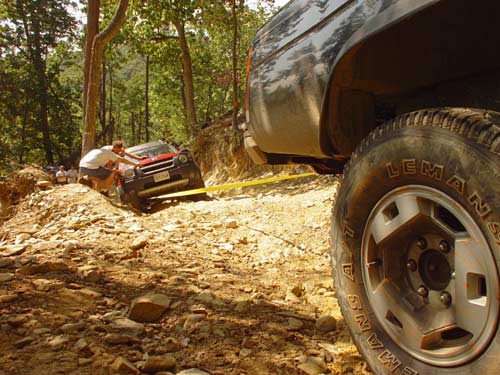
The picture above is a good example of the impact, which wide-angle give to the image. Let's review the picture a bit longer. Do you really believe that the wheel on the right is bigger than the car that is being towed? But how do you perceive the wheel? I am almost sure that the wheel is the first object in the image, which you see, and only then your eye follows the strap to the other car. What does it say to you? Well, may be not exactly what I wanted you to understand, so I will be explicit: The wide-angle lens is a great way to make the closest object stand out in your photograph and thus it attracts the attention.
Such a "behavior" of wide-angle perspective is a good tool to highlight the main subject in the photograph, but it only works when the subject is close to the camera. Or you may use it as I did in the photograph above - to make an object to be the initial point of entry into the photograph for our eye.
There is another way to take advantage of the highlighted wide-angle perspective (what a term ![]() ). The wide-angle lens makes the perspective noticeable and the sense of perspective could be the main point of your
photograph.
). The wide-angle lens makes the perspective noticeable and the sense of perspective could be the main point of your
photograph.
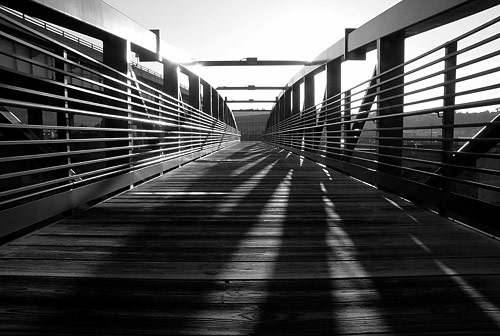
The photograph shown above is purely abstract - there is no subject, and even composition is very centric, but because of the converging lines, it adds this dynamic feeling. Such an effect is created by use of wide-angle lens, which makes the bridge look long enough, so the lines almost merge in a dot. But actually the bridge was about 30 feet (10 meters) and wouldn't look so beautifull with a normal lens. In my other article I talk in more details about this lens and how it affects the photograph.
You may consider to use the wide-angle lens even for taking portraits of people. Of course, it won't be usual, and that's again the main point of such portraits - the distortion makes the portraits interesting and can express different moods and views on subjects. At the time of writing the article I haven't tried such an approach, but I have seen some photographs of people taken with a wide-angle lens and here where taken by Lichtenwalter.
~ Top ~Medium Range
The medium range lens could seem boring because such lens don't have any unusual point of view, so you may be wondering "what use of it?". Well this range has its own advantages. First lets refresh our memory about medium range, what so usual about this range. Funny, but the answer is in the question itself - it's very usual. It means that the lens will not distort our vision of what is in the photograph. And it is a great advantage of the lens - when in our photographs we need the exact (or very close) representation of what we see - we use the medium range lens. Such challenges arise when photographers have to make commercial photographs of products or especially people. It is widely recommended to take portraits of people with "portrait" lens, which are from 80mm to 135mm of focal length. This portrait range is slightly longer than "normal" lens, which is considered to be 50mm. There is one strange thing, mostly "normal lens" are known as 50mm, but somewhere I read that 35mm is much closer or event is the "normal lens" (have the same angle as the human eye). However I have to say, that in my experience the closest representation of reality was with 70mm range.
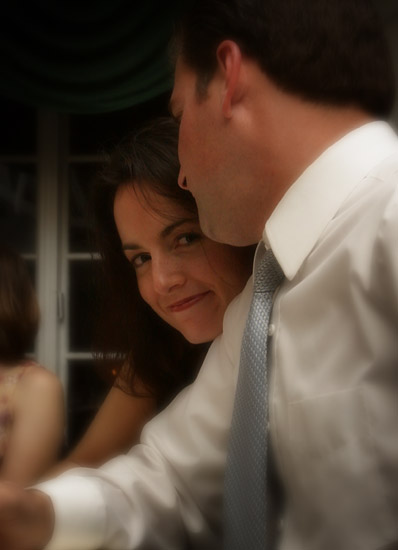
What kind of ramifications could be there if we use other than medium or "portrait" lens you may ask. Well, lets see. As we already know the wide-angle lens would increase the sense of perspective and the telephoto lens will do the contrary. So, the first ramification is a nose, which is too big (wide-angle) or opposite - the face looks flat (telephoto).
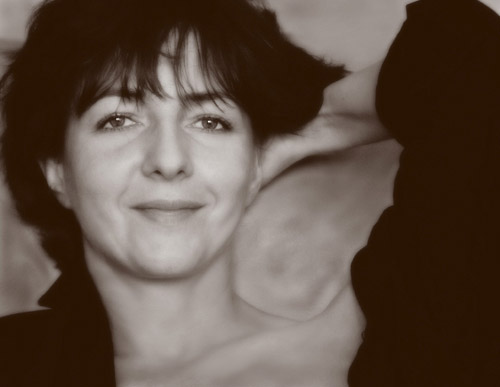
But there is an interesting fact: some of the renowned photographers use telephoto lens to make portraits. Such an approach forces them to be more than 100 feet (30 meters) away from the subject and sometimes they even use a walky-talky to talk with the model. Well, every approach has drawbacks, but there are sacrifices to take, if we are to create Art
Telephoto
And now we came to a telephoto lens. What can I say about this lens? It's a nice spy lens. It was a joke, of course, but there certain truth in the joke - with such lens you can reach certain places, where you would need to walk or drive. But that's not the point, the point is that the lens "flatten" the perspective. Remember? The telephoto lens make objects almost of the same size even when they are far away from the camera. Where can it help us? Well, what if we need a mixture of a man and a building that is far away (behind the person)? If we use a wide-angle lens or even the normal ones the building will be small and could even disappear in the background. Telephoto lens could help us. By using them we flatten the perspective and the sense of size is less vivid, so the building still has a significant size. If you notice most of the photojournalists on a football game use a telephoto lens. Do you remember when there is a crowd on the background, what size the people appear there (in comparison with the players)? Yes, they don't look too much different in size, but there more than 100 yards that separate the players and the crowd.
Unfortunately, I don't own yet such a powerful telephoto lens to show some of my own pictures, but just open a newspaper and on a sport page and you will
see many examples of photographs taken with a telephoto lens. But what the telephoto lens gives us? The telephoto lens helps us to connect two objects -
they will look much closer too each other than they actually are or will look similar in size. Otherwise one of them (the farthest one) would almost
disappear in the background.![End of the article [end of the text]](http://www.romanzolin.com/img/misc/text_end.png)
